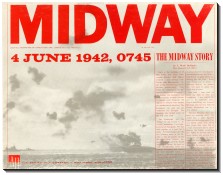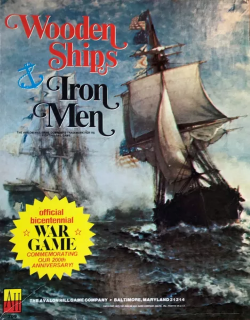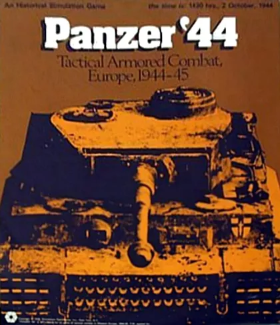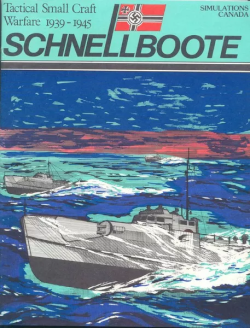
Midway is a board wargame published by Avalon Hill in 1964 that simulates the Battle of Midway during World War II.

Wooden Ships and Iron Men is a naval board wargame simulating naval combat during the Age of Sail that was published by Battleline Publications in 1974, then revised and republished by Avalon Hill the following year.

The Campaign for North Africa, subtitled "The Desert War, 1940–43", and generally referred to as CNA by wargamers, is a strategic "monster" board wargame published by Simulations Publications, Inc. (SPI) in 1978 that simulates the entire North African Campaign of World War II.

Jutland is a naval board wargame published by Avalon Hill in 1967 that simulates the Battle of Jutland in the North Sea during World War I. Upon its release, Jutland was commended for its gameplay and mechanics, but criticism surrounded the complex rules and playing time.

Air Force is a board wargame published by Battleline Publications in 1976, and subsequently re-released by Avalon Hill in 1977, that simulates air combat during World War II. Several expansions for the game were also published.

Armageddon: Tactical Combat, 3000-500 BC is a board wargame first published by Simulations Publications Inc. (SPI) in 1972 in Strategy & Tactics, then released as a stand-alone game, then reimplemented as Chariot: Tactical Warfare in the "Biblical" Age, 3000-500 BC.

Alpha Omega is a science fiction board wargame published by Battleline Publications in 1977 that simulates combat between alien and human space fleets. Avalon Hill acquired the game and republished it in 1980.

Indian Ocean Adventure: The Japanese Raids on Ceylon is a board wargame published by Game Designers' Workshop (GDW) in 1978 that simulates the World War II naval raid on Ceylon by a Japanese aircraft carrier fleet.

Narvik: The Campaign in Norway, 1940 is a board wargame published by Game Designers' Workshop (GDW) in 1974 that simulates Operation Weserübung, the German invasion of Denmark and Norway during World War II. The game was one of the first in the Europa series of twenty interlocking games envisioned by GDW that would cover the entire European and North African theatres from the start to the end of World War II, using identical map scales and similar rules.

Ironbottom Sound, subtitled "The Guadalcanal Campaign", is a naval board wargame published by Quarterdeck Games in 1981 that simulates the Naval Battle of Guadalcanal during World War II. Four editions have been released by various publishers over forty years.

Kriegsmarine is a board wargame published by Simulations Canada (SimCan) in 1980 that is a simulation of tactical naval comabt in the Atlantic and Mediterranean during World War II.

'CA': Tactical Naval Warfare in the Pacific, 1941-45 is a board wargame published by Simulations Publications Inc. (SPI) in 1973 that simulates surface naval battles during the Pacific Campaign of the Second World War.

Global War, subtitled "The War Against Germany and Japan, 1939–45", is a grand strategic and economic board wargame published by Simulations Publications Inc. (SPI) in 1975 that simulates the entire extent of World War II.

Coral Sea, subtitled "Turning the Japanese Advance, 1942", is a board wargame published by Game Designers' Workshop (GDW) in 1974 that simulates the Battle of the Coral Sea in the Pacific Theater of World War II.
Tsushima is a board wargame published by Game Designers' Workshop (GDW) in 1975 that simulates naval battles during the Russo-Japanese War of 1904-1905. Tsushima was part of a two-game collection titled The Russo-Japanese War. The second game in the box was Port Arthur, which covered the land combat during the war. The two games could either be played separately, or combined into one master game.

Frigate: Sea War in the Age of Sail is a board wargame published by Simulations Publications Inc. (SPI) in 1974 that simulates naval combat in the 18th and 19th century Age of Sail.

Panzer '44: Tactical Combat in Western Europe, 1944–45 is a board wargame published by Simulations Publications Inc. (SPI) in 1975 that simulates historical tank combat during World War II.

IJN, subtitled "A Tactical Game of Naval and Naval-Air Combat in The Pacific, 1941–1945," is a board wargame published by Simulations Canada in 1978 that simulates various naval encounters during the Pacific Campaign of World War II. It was the first in a series of three interlocking naval wargames.

Torpedo!, subtitled "A Tactical Study of Submarine and Anti-Submarine Warfare, 1941–1945," is a board wargame published by Simulations Canada in 1979 that simulates various naval engagements involving submarines World War II. It was the second in a series of three interlocking naval wargames.

Schnellboote, subtitled "Tactical Small Craft Warfare, 1941–1945," is a board wargame published by Simulations Canada in 1984 that simulates various naval engagements involving small craft such as PT boats and E boats. It was the third in a series of three interlocking naval wargames.


















